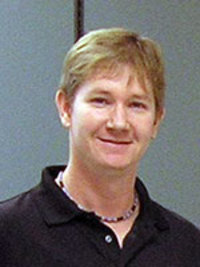John York
Professor of Chemistry
Dr. York is a professor of chemistry with expertise in inorganic, organometallic and biological inorganic chemistry.
- PhD, inorganic chemistry, University of Minnesota
- BA, secondary science education, University of Wyoming
- BS, chemical engineering, North Carolina State University

Biography
John York is a professor of chemistry with expertise in inorganic, organometallic and biological inorganic chemistry. He is originally from North Carolina, but has lived in Delaware, Wyoming and Minnesota as well.
More About John York
Areas of Expertise
- Transition Metal Chemistry
- Catalysts and Chemical Reactions
- Organometallic Chemistry
- Biological and Inorganic Chemistry
- Chemical Education
Course Sampling
- General Chemistry
- Organic Chemistry
- Inorganic Chemistry
- Biological Inorganic Chemistry
- First-Year Seminar (Medicines, Drugs, and Toxins)
- Use of transition metal compounds to perform important chemical transformations
- How copper functions in both biological and industrial systems to bind with important organic molecules like alkenes and thiophenes
- Development of innovative techniques and materials for teaching chemistry to undergraduate students
- Geri, J. B.; York, J. T. "A Systematic Examination of Ligand Basicity Effects on Binding in Palladium(0)- and Palladium(II)-Ethylene Adducts." Inorganica Chimica Acta 2018, 483, 191.
- Tran, V.; Allen, K. E.; Chavez, M. G.; Aaron, C.; Dumais,J. J.; York, J. T.; Brown, E. C. "Solution and Solid-State Characterization of Zn(II) Complexes Containing a New Tridentate N2S Ligand." Polyhedron 2018, 147, 131.
- Greene, C.; Grudzien, P. K.; York, J. T. "Binding and Electrophilic Activation of Ethylene by Zinc(II), Cadmium(II), and Mercury(II) Complexes: A Theoretical Investigation." Journal of Organometallic Chemistry 2017, 851, 122.
- York, J. T. "Determining the Impact of Ligand and Alkene Substituents on Bonding in Gold(I)-Alkene Complexes Supported by N-Heterocyclic Carbenes: A Computational Study." Journal of Physical Chemistry A. 2016, 120, 6064.
- Geri, J. B.; Pernicone, N. C.; York, J. T. "Comparing the Impact of Different Supporting Ligands on Copper(I)-Ethylene Interactions." Polyhedron (Invited Submission, Special 100th Anniversary of Alfred Werner Nobel Prize Edition) 2013, 52, 207.
- Pernicone, N. C.; Geri, J. B.; York, J. T. "Examining the Impact of Ancillary Ligand Basicity on Copper(I)-Ethylene Binding Interactions: A DFT Study." Theoretical Chemistry Accounts 2012, 131, 1105.
- Spiropulos, N. G.; Chingas, G. C.; Sullivan, M.; York, J. T.; Brown, E. C. "Examining the Impact of Steric and Electronic Variation in N2S Scorpionate Ligands on the Properties of Zinc(II) and Cadmium(II) Complexes." Inorganica Chimica Acta 2011, 376, 562.
- Pernicone, N. C.; Geri, J. G.; York, J. T. "Using a Combination of Experimental and Computational Methods to Explore the Impact of Metal Identity and Ligand Field Strength on the Electronic Structure of Metal Ions". Journal of Chemical Education 2011, 88, 1323.
- Morris, A. L.; York, J. T. "Quantifying the Electron Donating Strength of Phosphine Ligands". Journal of Chemical Education 2009, 86, 1408.
- Lewis, M. E.; Levine, R. M.; York, J. T.; Grubbs, W. T. "A Quick and Accurate Oxygen-Based Pressure-Sensor Assay for Catalase Activity". Journal of Chemical Education 2009, 86, 1227.